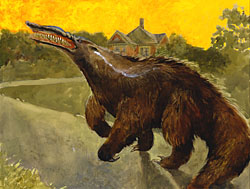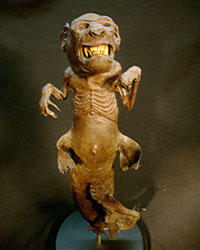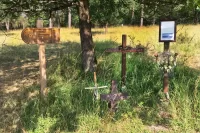'Cryptozoology' transcends Nessie, yeti in exploring hidden creatures
Some, like the Tasmanian tiger, are considered extinct, yet sightings are still reported. Some, like the giant squid, existed only as rumors until hard evidence finally appeared. And roaming a shadowy habitat between myth, hucksterism and science are still others — for example, Bigfoot and the Loch Ness Monster.
Such creatures are the subjects of cryptozoology, the study of unknown, rumored or hidden animals. This summer, in the major exhibition Cryptozoology: Out of Time Place Scale, the Bates College Museum of Art presents 16 artists in a wide-ranging examination of a field enjoying an increasingly high profile in pop culture.
The exhibition opens June 23 and runs through Oct. 8 at the Bates museum, 75 Russell St. The museum is open from 10 a.m. until 5 p.m. Tuesday through Saturday, and is closed Mondays and major holidays. Admission is free. For more information, please visit the museum’s Web site or contact the museum at 207-786-6158 or this museum@bates.edu.
The exhibition is curated by Bates museum director Mark H.C. Bessire and Raechell Smith, director of the H&R Block Artspace at the Kansas City Art Institute, where it opens in late October.
“It really has been an artist-driven project,” says Bessire, as the curators became aware of the number of well-known artists making work that crossed the borders between environmental science, pop culture and cryptozoology itself.
“Then, underneath those big ideas were ideas that, I think, are very interesting in terms of contemporary life — myth, spectacle, fraud,” Bessire says. “Those three topics also turn up within the guise of cryptozoology. Those are fruitful areas for artists, and the work in this show opens up a conversation for all of these topics.”
Artworks in the exhibition run a gamut of gamuts in terms of media, themes and perspectives. They include dioramas, taxidermy and performative photo series, along with more conventional media. The 16 artists include Mark Dion, whose “hallway” installation, Bessire writes, evokes “the timeless institutional feel of a government agency, a historical college (like Bates College) or a museum”; Rachel Berwick, who made three-dimensional models of a Tasmanian tiger, or thylacine, derived from film taken in the 1920s of the last known living specimen; and Jamie Wyeth, who shows images of a beast designed for the Stephen King television series Kingdom Hospital.
The exhibition is presented in conjunction with a film series (schedule to be determined) and a major publication that includes essays by exhibiting artists, Bates anthropologist Loring Danforth and Maine’s own Loren Coleman, who is considered the leading American cryptozoologist.
After Bates, Cryptozoology: Out of Time Place Scale travels to the Block Artspace, where it will be shown from Oct. 27 until Dec. 20.




